Ijraset Journal For Research in Applied Science and Engineering Technology
- Home / Ijraset
- On This Page
- Abstract
- Introduction
- References
- Copyright
Multi-Functional Blind Stick for Visually Impaired People
Authors: Manasa M N, Gagana S, Deeksha N, Meghana N, Prakruthi
DOI Link: https://doi.org/10.22214/ijraset.2022.45057
Certificate: View Certificate
Abstract
Getting around, whether indoors or outdoors, is one of the most difficult tasks for the visually impaired. Furthermore, the poor state of the roads makes walking outside even more difficult for them.They must remain vigilant at all times to avoid dangerous situations such as colliding with stationary or moving obstacles, ascending or descending staircases, or slipping on damp terrain. They may also be distressed and wish to send an alarm message to their relatives or friends about their whereabouts. The issues that blind individuals face can be solved with the use of technology. To offer a medium between the blind and the environment, the suggested solution uses the Internet of Things (IoT) paradigm. Several sensors can be used Obstacles, staircases, and damp terrains are all examples of abnormalities that can be detected. The smart blind stick prototype presented here is a simple, intelligent, and cost-effective smart blind stick with a variety of IoT sensors and modules. Also included in this solution is the ability to send a message to those who are concerned about the user\'s whereabouts. In addition, a software programme is being developed to assist blind acquaintances in managing the stick\'s setup, such as adding or deleting phone numbers to which alarm messages must be sent. Indoors, misplacing the stick might be a serious problem. This solution also deals with the issue.
Introduction
I. INTRODUCTION
According to the World Health Organization, almost 285 million people worldwide suffer from some sort of visual impairment, with 86 percent having impaired vision and 14 percent being blind. Human vision is one of the most vital senses for survival. Vision aids in establishing a connection with the environment. People who are blind rely on alternative resources, such as a modest walking cane or other people. They learn site directions, impediments on their way, and navigate according to them in familiar settings like the interiors of a house. However, relying on one's recollection to get from one place to another is not always safe for the blind. Especially when they're out in the open. Blind persons are not always afforded assistance there is a need for a device, such as a stick, that can assist visually impaired people in all aspects of their lives.The stick's main criteria for it to be useful to any visually impaired person are efficiency and cost effectiveness. People, vehicles, and stones in the outside, as well as stairs, walls, and impediments on the stick, there's a speaker. The stick can also detect moist or damp surfaces and provide the user a vibrational signal. A mobile phone does not efficiently fulfil the aim of sending a panic message to a visually impaired individual who finds himself in an unfamiliar environment. Sending a message to the blind person's pals is as simple as pressing a button on the stick. The phone numbers of acquaintances can be changed, added, or deleted using a software application. The supplier, who has admin authority to update the phone numbers, can also help the user set up the phone numbers. If a stick is misplaced, a remote can help the user there is a button on the stick that, when pressed, makes a buzzer sound.
II. CONNECTED WORK
The Smart Blind Stick is a cutting-edge device that helps visually impaired persons navigate more easily. Using a water sensor, ultrasonic sensor, RF module, and GSM module installed in it, M. P. Agrawal's smart stick [1] can detect all obstructions in the path and send vibrations to the user to alert them to any hazards. A water sensor is included into R. F. Olanrewaju's blind stick, iWalk [2], which activates a separate beep if it senses water. The system also includes a sound-producing wireless RF remote control when pressed, which aids in the detection of the stick K. B. Swain [3] presented a stick guide model that includes GPS and GSM and sends SMS whenever the person requires assistance. It detects obstructions with an ultrasonic sensor and detects levels with an infrared sensor.
Nadia Nowshin [4] presented an Arduino Nano-based stick that uses Ultrasonic sensors to identify impediments and an Android mobile application to assist a blind person. With the use of infrared, ultrasonic, and water sensors, Radhika R [5] constructed a model that can identify obstructions within a 3m range. The blind person can also use GPS and GSM modules to convey his location to his guardian. Manikanta K [6] has created a blind stick that has an ultrasonic sensor, as well as light and water detection. When an impediment is spotted close enough, it sends a signal to sound a buzzer. When an obstruction is detected, O.B. Al-Barrm proposed a 3D ultrasonic walking stick with buzzer and vibration motors. The stick also has GPS and GSM capabilities, allowing blind people's locations to be communicated. The ultrasonic sensor, which is utilised to scan a preset region around blind by P. Sharma [8], is the most important component of the system Waves are emitted and reflected. The microcontroller then uses SD Card Technology to convey the state of a specific device to the headphones. T.A. Ueda [9] created a mobile application that leverages the smartphone's camera to warn users about hazards in their route. V. Patel's second invention [10] is a wearable glove that allows the blind to securely travel on their own.The basic component of this system is an ultrasonic sensor that emits and reflects waves to scan direction.
III. CURRENT SYSTEM
Existing technologies, like as canes, can assist blind persons in navigating their environment by allowing them to detect obstacles in their route by touching or poking them. Smart belts, smart rings, smart canes, and other aids, in addition to the previous way, can assist users by detecting obstructions using ultrasonic or laser sensors. To warn them, these technologies emit an audio or vibration in response to the detected obstructions. Existing systems have the following limitations:
- Expensive
- Ineffective and unreliable
- Features and usefulness are severely constrained.
IV. SYSTEM PROPOSED
The following units make up the suggested model, which monitor the situation and take appropriate action.
Block diagram:
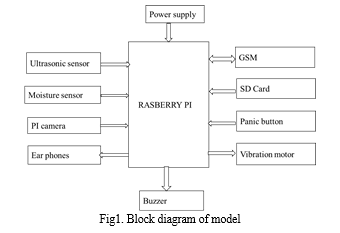
V. REQUIREMENTS
- Ultrasonic Sensor: Using sound waves, an ultrasonic sensor (see Fig. 2) can be used to estimate the distance to the target. It sends out a sound wave at a specific frequency and waits for it to return. It can determine distance by computing the elapsed time between these two events. Two ultrasonic sensors have been mounted on the stick in order to to detect various barriers like as people, vehicles, stones, and walls, furniture in the outdoors and interiors. The suggested system employs an HC-SR04 ultrasonic sensor with a theoretical measuring range of 2cm to 450cm. A soil moisture sensor (shown in Figure 3) is used to detect the presence of water in the path of blind individuals. The sensor's two probes serve as variable resistors. When they're placed on a moist surface, electricity conducts more readily, resulting in low resistance. Because electricity conducts poorly on dry surfaces, additional resistance is offered. The sensor reads the resistance between these two probes to determine the moisture level.
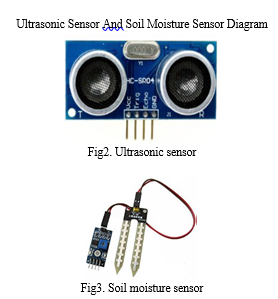
2. GSM Module: (see Fig. 4) is used to track the current location of a blind person by retrieving the individual's GPS coordinates. The blind person's coordinates are sent to relevant contacts using a GSM module (SIM 900A) .
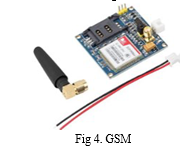
3. A push Button: (see Fig.5) serves as an emergency/distress signal to the user, and when pressed, it can send the user's location in the form of a message to the appropriate contacts in the event of an emergency.
4. Speaker: When an impediment is recognised, a speaker (see Fig.6) is used to send notifications to the blind individual. It's got a voice recorder built in, so you can get unique audio alarms for different types of obstacles.
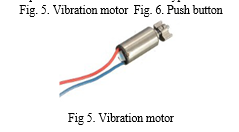
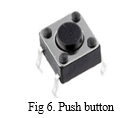
5. Power Supply: The controller is powered by a 5 V rechargeable Li-ion battery (see Fig.7), which then delivers the appropriate power to all the sensors and modules linked to it.
6. Raspberry Pi: The Raspberry pi is a series of small single-board computers (SBCs) developed in the United Kingdom by the Raspberry Pi Foundation in association with Broadcom.The Raspberry Pi project originally leaned towards the promotion of teaching basic computer science in schools and in developing countries.The original model became more popular than anticipated, selling outside its target market for uses such as robotics. It is widely used in many areas, such as for weather monitoring,[19] because of its low cost, modularity, and open design. It is typically used by computer and electronic hobbyists, due to its adoption of the HDMI and USB standards.
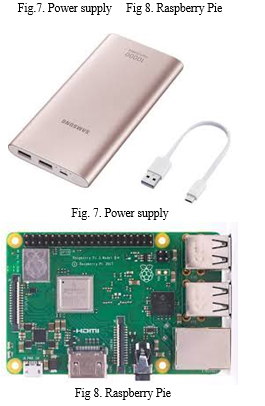
VI. METHODOLOGY
All of the above-mentioned components in the IV Section make up the proposed system. Jumper wires link these components to the Arduino digital and analogue pins. The suggested system includes the following properties and runs on a 9V/12V input voltage. It can scan the environment for various impediments of varied sizes and issue audio and vibratory alerts as needed. It can detect moist and wet surfaces and provide the user an alarm. It can also convey the user's location to friends via SMS in the event of an emergency or crisis, and it can be located via an RF remote control if it is misplaced. The Arduino algorithm polls each of the sensors for input and follows the flow shown in the flow chart below.
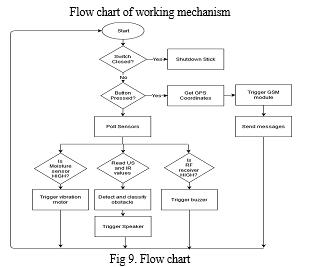
The following are the states that each state correlates to:
- To detect impediments, the algorithm employs ultrasonic sensors, obstacles of all shapes and sizes can be detected with this configuration. The type of obstacle is determined by the logic in below after processing the input from these sensors, and the appropriate vibration pattern is broadcast to the user via the speaker module or vibration motor.
- The moisture sensor's operation is straightforward: after scanning the surface, the sensor produces a boolean output, which the algorithm uses to raise a vibratory alert to the user via the vibration motor at the stick's top end.
- When the user presses a button, the GSM module is polled for the user's coordinates.These coordinates are represented as a google maps link, such as "http://maps.google.com/maps?q=12.9835,77.4946:."The URL is then prepended with an appropriate message, such as "Emergency alert!….location is:," and transmitted to the User's caregivers via the GSM module.
VII. OBJECTIVES AND OUTCOMES
The proposed prototype was consistently effective at recognising numerous impediments of varied sizes in the user's route, and it was able to send SMS to his acquaintances with correct user coordinates. Within a 100m range, the Ultrasonic sensor module (Transmitter and Receiver) can efficiently communicate.
The components are put on the prototype (see Fig. 9), which is a 96-cm-long PVC pipe with a diameter of 2cm.
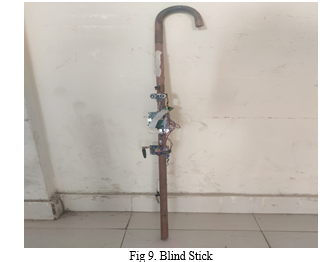
The GSM modules are operational and can send and receive messages (see Fig.10) as well as provide accurate location information for the user. The Neo-6M GPS module, on the other hand, needs a variable amount of time to obtain a satellite lock on starting (30s to 1m). The soil moisture sensor can accurately assess whether or not the surface is wet. Finally, utilising the infrared and ultrasonic sensors, the speaker module and vibration motor are able to detect the impediments listed.

VII. FINAL THOUGHTS AND OUTLOOK
The blind stick presented in this research can assist the visually impaired user in navigating various terrains and obstacles. In the event of an emergency or trouble, the stick can also notify the user's caretakers of their whereabouts. The stick can also be found with the use of an RF remote control. This can be improved further by adding tiny scale and high performing sensors, which will improve the design while also reducing the amount of space taken up on the stick. A few adjustments to the sensor angle placement can be made to have them adjust according to the angle of the stick relative to the ground so that they always point straight rather than being mounted at a static angle. It can also be improved by adopting a better material for the stick's body, such as carbon fibre, to make it lighter and more flexible to use
References
[1] M. P. Agrawal and A. R. Gupta, \"Smart Stick for the Blind and Visually Impaired People,\" Proceedings of the Second International Conference on Inventive Communication and Computational Technologies (ICICCT), pp. 542- 545, 2018. [2] IEEE 4th International Conference on Smart Instrumentation, Measurement, and Application (ICSIMA), pp. 1-4, 2017. R. F. Olanrewaju, M. L. A. M. Radzi, and M. Rehab, \"iWalk: Intelligent walking stick for visually impaired subjects,\" IEEE 4th International Conference on Smart Instrumentation, Measurement, and Application (ICSIMA), pp. 1-4, 2017. [3] K. B. Swain, R. K. Patnaik, S. Pal, R. Rajeswari, A. Mishra, and C. Dash, \"Arduino-based automated STICK GUIDE for a visually impaired person,\" IEEE International Conference on Smart Technologies and Management for Computing, Communication, Controls, Energy, and Materials (ICSTM), pp. 407–410, 2017. [4] \"An Intelligent Walking Stick for the VisuallyImpaired People,\" International Journal of Online and Biomedical Engineering (iJOE), vol. 13, No. 11, 2017. Nadia Nowshin, Sakib Shadman, Saha Joy, Sarker Aninda, Islam Md Minhajul, \"An Intelligent Walking Stick for the Visually Impaired People,\" International Journal of Online and Biomedical Engineering (iJOE), vol. 13, No. 11, 2017. [5] Radhika R, Payal G Pai, Rakshitha S, and Rampur Srinath, \"Implementation of Smart Stick for Obstacle Detection and Navigation,\" International Journal of Latest Research in Engineering and Technology (IJLRET), vol. 02, no. 2, pp. 45-50, 2016. [6] \"Implementation and Design of Smart Blind Stick for Obstacle Detection and Navigation System,\" Manikanta K, T. Siva Sankara Phani, and A. Pravin, 2018. [7] \"3D ultrasonic stick for blind,\" O.B. Al-Barrm and J. Vinouth, International Journal of Latest Trends in Engineering and Technology (IJLTET), vol. 3, 2014. [8] P. Sharma and S.L. Shimi, \"Design and development of a virtual eye for the blind,\" International Journal of Innovative Research in Electrical Electronics Instrumentation and Control Engineering, vol. 3 no. 3 (2015), pp. 26-33. [9] T.A. Ueda and L.V. de Araujo, \"Virtual walking stick: A mobile app to help visually impaired persons walk safely,\" International Conference on Universal Access in Human-Computer Interaction, pp. 803-813, 2014. [10] V. Patel, \"The Digitalization of the Blind Walking Stick,\" International Journal of Scientific and Engineering Research, vol. 6, no. 4, pp. 1142-1145, 2015. [11] P. Bhardwaj and J. Singh, \"Design and development of a secure navigation system for visually impaired people,\" International Journal of Computer Science and Information Technology, vol. 5, no. 4, pp. 159-164, 2013. [12] G. Gayathri, M. Vishnupriya, R. Nandhini, and M.M. Banupriya, \"Smart walking stick for the visually handicapped,\" International Journal Of Engineering And Computer Science (IJECS), vol. 3 no. 3, pp. 4057-4061, 2014. [13] Y. Chang, N. Sahoo, and H. Lin, IEEE International Conference on Applied System Invention (ICASI), pp. 113-116, 2018. [14] Chitra. M, Anushree Harsur, \"Voice Based Navigation System for Blind People Using Ultrasonic Sensor,\" International Journal on Recent and Innovation Trends in Computing and Communication, vol. 3 no. 6, pp. 4117-4122, 2015. [15] R. Bhambare, A. Koul, S. Bilal, and S. Pandey, \"Smart Vision System for Blind,\" International Journal of Engineering and Computer Science, vol. 3 no. 5, 2014, pp. 5790-5795. [16] S. Gupta, I. Sharma, A. Tiwari, and G. Chitranshi, \"Advanced guide cane for visually impaired people,\" 1st International Conference on Next Generation Computing Technologies (NGCT), pp. 452-455, 2015. [17] IOSR Journal of Electronics and Communication Engineering (IOSR-JECE), pp. 11-15, 2015. [17] Adhe, Shubham, Sachin Kunthewad, Preetam Shinde, and Mrs VS Kulkarni, \"Ultrasonic Smart Stick for Visually Impaired People,\" IOSR Journal of Electronics and Communication Engineering (IOSR-JECE), pp. 11-15, 2015. [18] A. Mahdi Safaa, H. Muhsin Asaad, and I Al-Mosawi Ali, \"Using Ultrasonic Sensor for Blind and Deaf Persons Combines Voice Alert with Vibration Properties,\" Research Journal of Recent Sciences, vol. 1 no. 11 (2012), pp. 5052. [19] \"Ultrasonic spectacles and waist-belt for visually impaired and blind people,\" National Conference on Communications (NCC), pp. 1-4, 2012. S. S. Bhatlawande, J. Mukhopadhyay, and M. Mahadevappa, \"Ultrasonic spectacles and waist-belt for visually impaired and blind people,\" National Conference on Communications (NCC), pp. 1-4, 2012. [20] A. B. Yadav, L. Bindal, V. U. Namhakumar, K. Namitha, and H. Harsha, IEEE International Conference on Recent Trends in Electronics, Information, and Communication Technology (RTEICT), pp. 1506-1509, 2016.
Copyright
Copyright © 2022 Manasa M N, Gagana S, Deeksha N, Meghana N, Prakruthi . This is an open access article distributed under the Creative Commons Attribution License, which permits unrestricted use, distribution, and reproduction in any medium, provided the original work is properly cited.

Download Paper
Paper Id : IJRASET45057
Publish Date : 2022-06-29
ISSN : 2321-9653
Publisher Name : IJRASET
DOI Link : Click Here
 Submit Paper Online
Submit Paper Online

